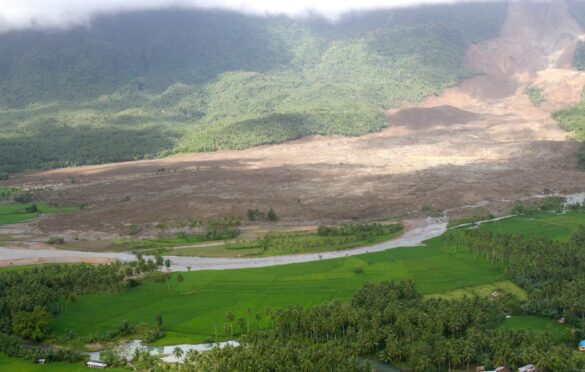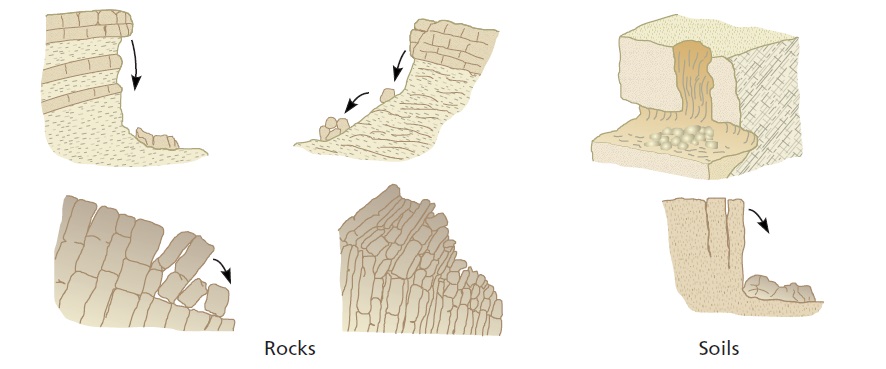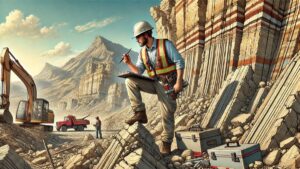Mass movements

Geodynamic processes affecting the earth’s surface cause mass movements of different types, size and speed.
Slope movement is the most frequent and widespread type of mass movement, generated by the gravitational down slope displacement of soil and rock masses. Subsidence is less common, as it is associated with specific materials and circumstances.
The force of gravity and the progressive weakening of geological materials, mainly due to weathering, together with the action of other natural and environmental phenomena, make mass movements relatively common in the earth’s surface.
These processes create potential geological risks, as they can cause economic loss and social damage if they affect human activities, buildings and infrastructure. How to avoid these adverse effects is the subject of research into mass movements, including the study of their characteristics, instability mechanisms, controlling factors and causes. To carry out this research it is necessary to know the characteristics and the geological, geotechnical and hydrogeological properties of the soil and rock materials involved, and their mechanical behaviour, as well as thefactors that condition and trigger such movements.
Types of slope movements
Slope movements are usually classified on the basis of the materials involved, generally distinguishing between rocks, debris and soils, and on their mechanism and type of failure; other aspects are also considered, such as the ground water content and the rate and dimensions of the movement.
Specific classifications have also been set out for some materials, such as clays, or for some specific types of movements, such as flows. A simplified classification of different types of slope movements, based on failure mechanisms and types of materials involved.
Landslides


Landslides are movements of masses of soil or rock which slide, moving in relation to the substratum, on one or more failure surfaces, when the shear strength within these zones is exceeded. The mass is generally displaced as a whole, behaving as a unit; the rate of movement may vary considerably, but these processes tend to move rapidly, reaching considerable speeds, and can involve volumes up to several million cubic metres.
Sometimes, when the slide material does not reach equilibrium at the toe of the slope (because of its loss of strength, and its momentum), the mass may continue to move for hundreds of metres and reach very high speeds, generally causing a flow; rock landslides may also cause rock avalanches. Landslides may occur in debris (e.g. in colluvium), along the contact with the substratum or in very weathered and fractured rocky slopes, along the contact with the competent rock, and generally produce debris flows; these tend to occur in saturated material conditions. The term debris refers to loose, unconsolidated material, with a significant proportion of coarse material (Varnes, 1988).
Flows

Flows are mass movements of soil (mud or earth flows), debris (debris flows) or rocks blocks (rock fragment flows) often with a high water content, where the material behaves as a fluid, undergoing continuous deformation, but without having well-defined failure surfaces. Water is the main triggering factor because water decreases the strength of materials having low cohesion. Flows mainly affect sensitive clay soils which show considerable loss of strength when mobilised; these movements are not very deep in relation to their extent; they develop a glacier like morphology and may occur on slopes with low gradients (even less than 10°). The displaced masses may reach several kilometres.
Rock falls

Rock falls are very quick free falls of rock blocks which are dislodged from pre-existing discontinuity planes (tectonic,
bedding surfaces, tension cracks). The movement may be by a vertical fall, by a series of bounces or by rolling down the slope face. They are common on steep slopes in mountainous areas, on cliffs and in general on rock walls; the blocks are bounded by different sets of discontinuities, often forming wedge shaped blocks. The factors that cause them include erosion and loss of support for previously separated or loosened blocks in steep slopes, water pressures in discontinuities and tension cracks and seismic shakes.
Rock avalanches

Rock avalanches, called rock falls or complex movements in some classifications, are rapidly falling masses of rock and debris that detach themselves from steep slopes, sometimes accompanied by ice or snow. The rock masses disintegrate during their fall and form deposits of very different block size, with no rounding from abrasion, and a chaotic distribution.
Rock avalanche deposits are unstructured and have great porosity.
Avalanches are generally the result of large-scale landslides or rock falls which, because of the steep gradient on which they form and the lack of both structure and cohesion in their materials, travel down steep slopes at great speed.
Sometimes, speeds of over 100 km/h are reached, even when the masses are completely dry, because of the reduction in friction caused by the presence of air between the rock fragments. Water from precipitation or thaw, seismic movements and volcanic eruptions may each play an important role in triggering these processes.
Lateral displacements

This type of movement (also called lateral spreading in some classifications) refers to the movement of rock blocks or very coherent, cemented soil masses that rest on soft, deformable material. The blocks move slowly down very low gradient slopes. These movements are due to the loss of strength of the underlying material, which either flows or is deformed under the weight of the rigid blocks. Lateral spreading may also be caused by liquefaction of the underlying material or by lateral extrusion of soft, wet clays under the weight of the masses above them. These movements occur on gentle slopes and may be very extensive. The coherent upper layers may fragment into blocks, generating cracks, differential displacements, toppling or other types of deformation, and resulting in a chaotic appearance to the zones affected.



